| Please access the following URL if you want to secure using SSL. All pages in the site will be secure pages. |
https://secure02.blue.shared-server.net/www.fish-food.co.jp/message english 10.2021.html |
Welcome to FISH FOOD TIMES
Oct. 2021 issue No.214

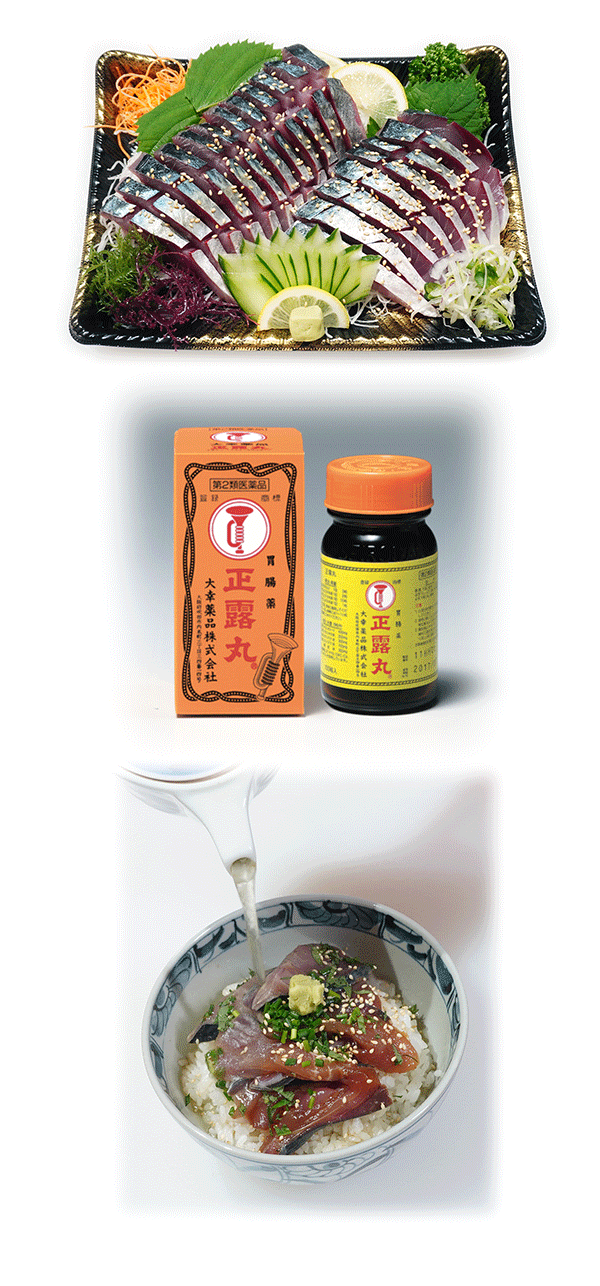
Sesame mackerel is safe with Seirogan
Mackerel sashimi is not sold in the store
For more than a decade, I've had one bitter feeling as one of the fish retailers. That is, the sashimi of so-called blue-backed fish such as mackerel, saury, and horse mackerel have disappeared one after another from fish section of supermarkets nationwide.
Mackerel in late autumn, saury in early autumn, horse mackerel in early summer, etc. are reasonably priced during the greasy season, and have been entertaining the Japanese tongue as various dishes such as sashimi and grilled salt as seasonal traditions. .. However, these fish sashimi have disappeared from fish section. The reason is that Anisakis poisoning cases have occurred frequently in recent years. Retailers don't want to take responsibility as the party that triggers the case, so they stopped selling in fish section as a way to avoid that responsibility.
| According to a summary by the Ministry of Health, Labor and Welfare, the number of food poisoning cases that occurred in Japan in 2019 was 1061, a decrease of 269 from the previous year. The number of patients decreased by 4,264 to 13,018, and the number of deaths increased by one to four. There were 689 cases with two or more patients, 64.9% of the total, but the number of patients was 12,646, accounting for 97.1% of the total. There were no outbreaks of food poisoning in more than 500 patients. In terms of the number of outbreaks by pathogen, Anisakis, which has seen a remarkable increase in recent years, has turned to a decrease, but it has been the highest for the second consecutive year with 328 cases (30.9%), Campylobacter 286 cases (27%), and Norovirus 212 cases. In order of cases (20%). These accounted for 77.9%, which is close to 80% of the total. Anisakis food poisoning increased from 124 cases in 2016 to 230 cases in 2017. In 2018, the number doubled to 468, surpassing Campylobacter to the highest number. In 2019, the number decreased by 140 from the previous year, but it was the highest for the second consecutive year.�@�@ (Excerpt from Nippon Consumer Newspaper article) |
FISH FOOD TIMES addressed the problem in the October 2014 issue No.130. However, the issue raised by the author did not reach the ears of fish retailers, and the tendency to stop selling blue-backed fish sashimi products became stronger. And although there are cooked vacuum products that some manufacturers dismantled blue-backed fish at the factory and proved that Anisakis is absent, the sashimi that retailers themselves cooked and commercialized whole fish disappeared from fish section of nationwide.
Mackerel, saury and horse mackerel no longer have an assortment of unfrozen raw sashimi in the fish section. Therefore, the lack of assortment of blue-backed fish sashimi, which should be the source of profits in the fisheries section, should have had a great impact on the management of the department.
Due to my profession, I have had the opportunity to eat countless blue-backed fish sashimi. Especially since I am from Fukuoka, I feel very uncomfortable that "sesame mackerel", which can be said to be one of the local food cultures, is no longer sold at supermarkets in Fukuoka as a risk avoidance measure for retailers.
Seirogan becomes a silver bullet to kill Anisakis
Live Anisakis is resistant to stomach acid and digestive enzymes in the stomach and can live in digestive juices for nearly a week. To prevent anisakiasis, freezing anisakis at -20 degrees for 24 hours or more, or heating at 60 degrees for 1 minute or more is effective, and there has been no silver bullet so far. In the case of gastric anisakiasis, anisakis has been removed using an endoscope.
However, there have recently been significant announcements related to this issue. It is said that "Seirogan", which is sold as an over-the-counter drug by Taiko Pharmaceutical, will be a silver bullet that kills Anisakis.
In a paper published in Hepato-Gastroenterology vol58, an international journal of German pharmacology, a patient suspected of having anisakiasis took Seirogan and his sharp abdominal pain disappeared in a minute or two. Anisakis larvae were found in the patient's stomach and were diagnosed with anisakiasis, but the patient recovered without being given a prescription.
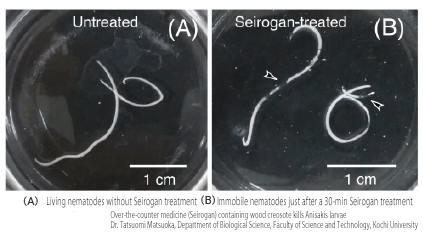
This was announced by the research group of Professor Tatsuomi Matsuoka of the Faculty of Science and Technology, Kochi University. When Anisakis was soaked in a solution of the gastrointestinal drug Seirogan at a normal dose for 30 minutes, it was confirmed that almost all Anisakis stopped exercising and died 24 hours later. When soaked in the same concentration of digestive enzyme pepsin as in the stomach, Anisakis began to break down within 24 hours. It has been announced that Seirogan may be the world's first silver bullet to kill Anisakis by relieving severe stomach pain caused by Anisakis in a single dose. DOI�F10.17352 / ojpp.000017 Over-the-counter medicine (Seirogan) containing wood creosote kills Anisakis larvae�@Dr. Tatsuomi Matsuoka, Department of Biological Science, Faculty of Science and Technology, Kochi University�@Published: 01 July, 2021
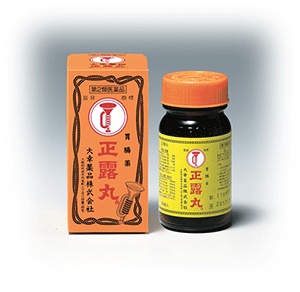
Seirogan has become a regular medicine at my home, and I have brought it as an indispensable carry-on medicine that is absolutely indispensable for overseas travel, and I have been active in the foreign countries I visited. Its efficacy is loose stool, diarrhea, food poisoning, water poisoning, vomiting, diarrhea due to indigestion, toothache, etc., and its effect on anisakiasis is out of the scope. Although it is not possible to express the efficacy of anisakiasis as Taiko Pharmaceutical at this stage, it has been announced by Taiko Pharmaceutical that it can be prevented by taking it in advance. As a pharmaceutical company, clinical research is required to add efficacy to anisakiasis, but it is difficult to collect as many patients with anisakiasis as necessary for research, and It seemed that is not easy to publish clinical results demonstrating the efficacy.
However, Taiko Pharmaceutical obtained a patent (Patent No. 5614801) in 2014 regarding the utilization of Seirogan's main ingredient, wood creosote, for its effect of suppressing the activity of Anisakis. Wood creosote is a refined liquid of wood tar obtained from logs such as beech and pine, and it is said that it can condition the intestines without affecting the balance of intestinal bacteria.
The author was actually surprised to learn that the main component of Seirogan is creosote. This is because the author, who has a hobby of DIY, has purchased a lot of creosote, a wood insect preservative, in a 14 kg can, and made his own wood deck with a length of 20 m, a height of 5 m, and a width of 53 �u, and a board with a height of 2 m. This is because it has been applied to walls and the like many times, and it is a familiar name that is always stocked in the warehouse.
From this information, I learned that Seirogan and the preservative creosote are basically made of the same ingredients, and I'm convinced that ... that unique odor certainly feels something similar ... There was something I could do.
Take advantage of the good news
Now, how will readers make use of this good news? The above information was just released on July 1, 2021, and is not yet common sense that everyone knows.
Blue-backed fish sashimi such as mackerel, saury, and horse mackerel are basically "cheap, delicious, and generous", although some people like and dislike them. And even if the markup ratio is set high on the selling side, the selling price does not become so high and it is an honor student in terms of profit. The fish sections nationwide did not assortment such sashimi, which has a win-win relationship between customers and sellers, for many years. Isn't it a wasteful story?
Until now, in the case of gastric anisakiasis, it had to be removed using an endoscope, but it has been announced that even if a sharp abdominal pain occurs when taking Seirogan, it may disappear in 1 to 2 minutes. If the fear of anisakiasis comes first, taking Seirogan first will reduce the chances of addiction to zero, just as some people take anti-hangover medicine before going to the liquor table.
What is the nationwide sales potential for blue-backed fish sashimi such as mackerel, saury and horse mackerel? Sales are likely to vary greatly from region to region, and should be quite large in western Japan, where many mackerels and horse mackerels are caught and the habit of eating well. Compared to this, it is speculated that the presence of blue-backed fish sashimi in eastern Japan is probably not high. After all, especially in western Japan, Fukuoka Prefecture has a long-standing food culture of eating mackerel sashimi, such as sesame mackerel sashimi. In neighboring prefectures Saga, Kumamoto, and Oita, the presence of mackerel sashimi is not as strong as in Fukuoka from the empirical sense of the author, while all prefectures have a similar large presence in terms of horse mackerel sashimi.
In order to avoid becoming a party to Anisakis addiction, there were a series of supermarkets that stopped selling blue-backed sashimi, which is cheap, delicious, generous and often contributes to profits. .. As a result, although I didn't say such a radical thing as "Is it stupid ..., is it still a fish sales professional ...", I had a really bitter feeling in my heart.
There is not the indication for the sashimi as if it is dignified if it is old days and catch the Sea of Genkai which I sold as "mackerel for the sashimi" even in the fish section of the supermarket of Fukuoka, and in (the Sea of Japan side Tsushima warm current system group) and it cover it with the state of rigor mortis, and of course the state that it is not done asortment follows the sashimi of the mackerel now.
The following is the content described in the October 2014 issue of FISH FOOD TIMES No.130, but I dare to summarize it in order to solve the problem between Anisakis and sesame mackerel. This content overlaps with that time, so if you have already read it, you can skip it.
The first place, not only this, Anisakis it is a generic term for animal belonging roundworm in (roundworm) order Anisakis family Anisakis genus, as well as mackerel, many fish general of Blue-backed fish, such as sardines and horse mackerel, Anisakis is to parasitic also squid not least, you have found may be a tuna and cod. Such as whales and dolphins are the final host of Anisakis is in the sea, intermediate host of Anisakis that eat these, it is said, including crustaceans such as krill and fish of all the subject's almost. Speaking the extreme case, the possibility of oral ingestion becomes higher as the "fish of good alive", it is not possible to eat at all in the sashimi raw fish basically when I scared the Anisakis, was passed through the fire to do with freezing all I do not eat fish only in the form. By the effect of the health center of "reign of terror", the company that prohibit the sashimi mackerel seems to not a few super company, but has been revealed by the announcement of the survey results, that actually never enough fear so . Institutions of Tokyo Metropolitan Safety Research Center, investigated the reality of Anisakis mackerel across the country over the three years of 2007-2009. As a result, Anisakis more than 80% of it has been discovered from the Pacific Ocean system group mackerel is a kind of "Anisakis simplex", Anisakis of this kind was about 11.1% transition rate to meat from internal organs. 99 people 100 people in Anisakis patients in Japan's so this was a simplex species. And the other hand, Anisakis type to host the Tsushima warm current system group "Japan Sea side mackerel" called "Anisakis pegreffii" is, was that "0.1%" slightly rate to migrate to meat from internal organs. 80% of the mackerel to be caught in the Japan Sea side, is of such that it's Anisakis of this pegreffii species. In other words,'s little risk from Anisakiasis for mackerel of the Japan Sea side. It is of the opinion of the majority "that seep in Anisakis even though stayed with the viscera's okay to be removed firmly little. internal organs" is of that speaking from transitive empirical industry participants. If you think you want to eat sashimi mackerel, or would like to provide this in the store, is that if you purchase by selecting the mackerel Tsushima warm current system group (Japan Sea side), the risk is extremely low. Because there is this kind of fact that've learned empirically from a long time ago, in the form of "Sesame mackerel", eating habits in sashimi mackerel have been rooted in the region as a "food culture" from the old days in Hakata facing the Japan Sea side. Also be parasitic when the mackerel are migratory to southern waters mainly often Anisakis. So instead of the Japan Sea side, even in the waters of the Pacific Ocean side, individuals who have grown in such Sagami Bay, Ise Bay, Bungo of waters without the migration is relatively safe. |
Based on this knowledge, if a company advocates being a supermarket rooted in the region, it may be recognized as a supermarket loved by the people of the region only by making efforts to protect the food culture of the region. .. If we can get the good news of the "Seirogan effect", we should quickly eliminate the pitiful situation that Fukuoka's food culture of sesame mackerel can only be enjoyed by going to an izakaya, and change it for the better.
Let's revive sesame mackerel products
The good news of Seirogan this time is that it can be applied not only to mackerel but also to all fish including horse mackerel, saury and squid. However, I would like to deal with mackerel, which is likely to occur as an addiction case, and use it as a breakthrough to overcome the Anisakis disaster that has been suffering so far.
Sesame mackerel is not a "fish species blue mackerel", but it is eaten with "white sesame" topped on the sashimi, so mackerel sashimi has been named like this for a long time in Fukuoka. It has been popular as a local food culture.
On Monday, September 27th, I got two chub mackerels from the Sasu Fisheries Cooperative in Komoda, Izuhara-machi, Tsushima City, Nagasaki Prefecture, so let's first introduce the orthodox commercialization of the sesame mackerel sashimi.

Its size was less than 1 kg, and its freshness was rigor mortis. When I disassembled it, it was bright red and it seemed that there was still little fat on it, and I felt that it would be more delicious later in the season.
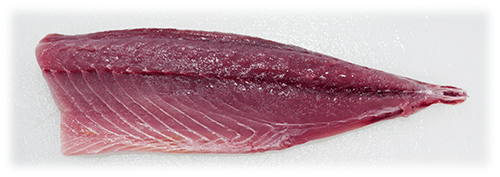
I decided to make this into three types of sesame mackerel sashimi. First of all, I decided to make hiratsukuri sashimi with half body and serve it. To do this, the chiai bone of fish must be removed, but even if you try to remove the fresh mackerel chiai bone of fish using a bone-removing tool, the bones are firmly attached to the body, so it is difficult to remove it. If you overdo it, the small bones will be cut off in the middle. Therefore, I decided to remove the chiai bone of fish by making a V-shaped notch next to the chiai bone of fish with a yanagiba knife as shown below.
| Serving half body of sesame mackerel sashimi |
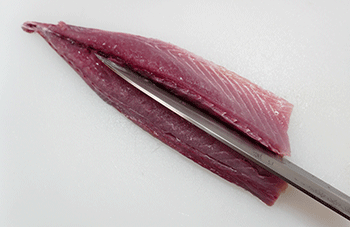 |
| �P�CMake a notch on the left side of the chiai bone of fish so that the cutting edge does not reach the skin. |
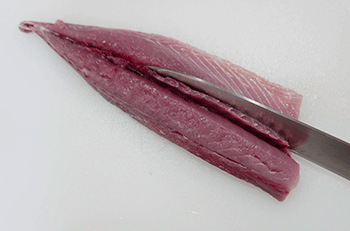 |
| �Q�CMake a similar cut on the right side of the chiai bone of fish. |
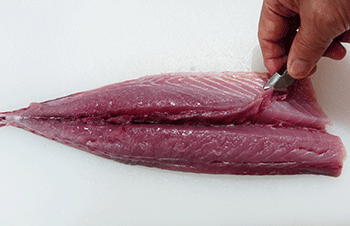 |
| �R�CGrab and remove the chiai bone of fish as a long mass. |
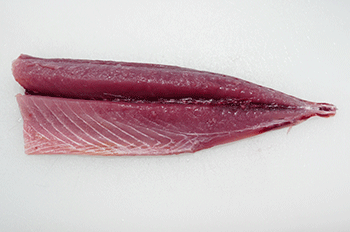 |
| �S�CThe chiai bone of fish has been removed in a V shape. |
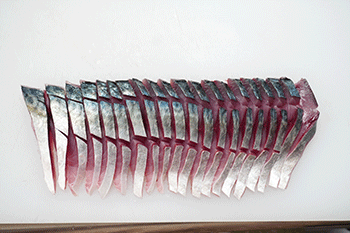 |
| �T�CPut a decorative cut in each of the back body and belly body, and then make it hiratsukuri sashimi. |
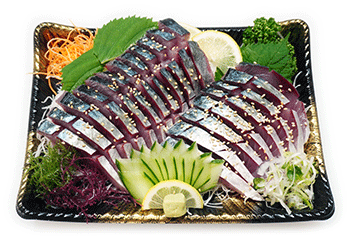 |
| Serving half body of sesame mackerel sashimi topped with white sesame |
Next is 1/4 serving of sesame mackerel sashimi divided into back body and belly body.
| 1/4 serving of sesame mackerel sashimi |
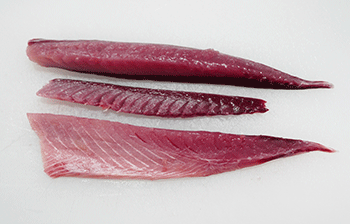 |
| �P�CPlace the skin down and cut the chiai bone of fish long into a V shape. |
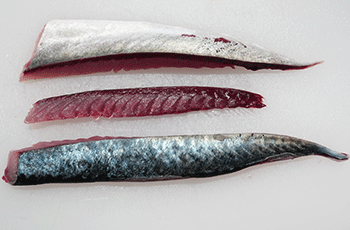 |
| �Q�CBy cutting with the skin down, the cut end becomes a sharp shape. |
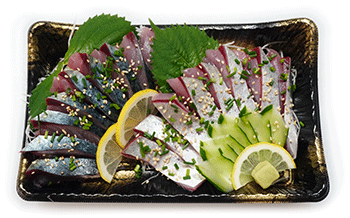 |
| Sesame mackerel sashimi topped with not only white sesame but also chopped green onions |
The above two were commercialized by hiratsukuri sashimi, but the next is a remnant of the era when chub mackerel was caught in large quantities and obtained at a very low price when purse seine fishing was popular in various parts of western Japan including Fukuoka a long time ago. This is a slightly rough method of commercialization called sesame mackerel, which is typical in Hakata.
| Hakata sesame mackerel |
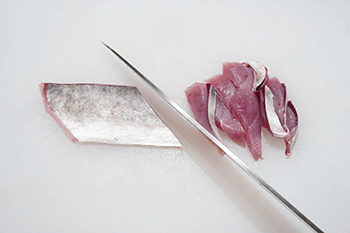 |
| �P�CCut the belly body into pieces that are not too thick. |
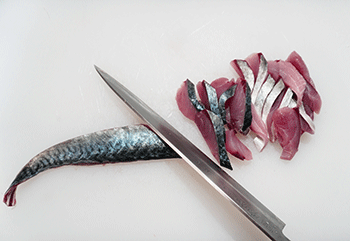 |
| �Q�CCut the back body appropriately so as not to make it thick. |
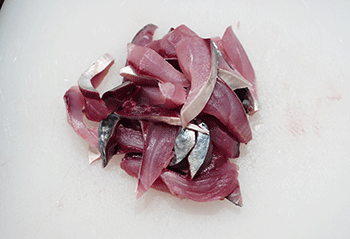 |
| �R�CCut them appropriately in thickness and length, and put them together. |
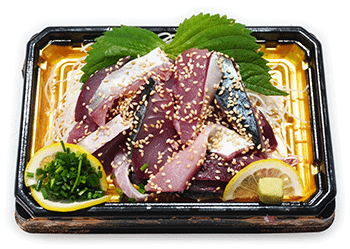 |
| Hakata sesame mackerel served on a tray and topped with white sesame seeds |
Eat sesame mackerel deliciously
The above sesame mackerel sashimi is basically ordinary sashimi that is supposed to be eaten with wasabi soy sauce or ginger soy sauce, but Hakata sesame mackerel can be eaten even more deliciously by adding some effort from here.
It's not just eating raw sesame mackerel, but making it a zuke.
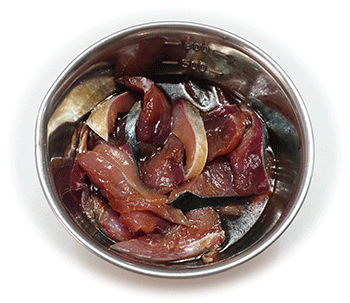
| Zuke sauce 1, 2 tablespoons soy sauce, 1 teaspoon sake 3, 1 tablespoon mirin |
If you drink sesame mackerel sashimi as a sake appetizer for dinner, do not eat all the sesame mackerel and soak the rest in the sauce as shown in the image above.
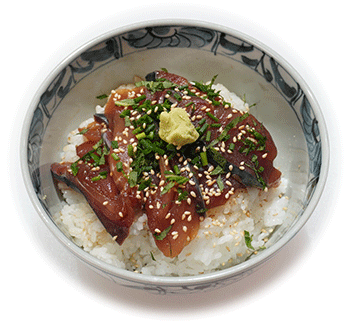
Place this zuke on rice and top with white sesame seeds, chopped green onions, chopped shiso leaves, wasabi, etc.
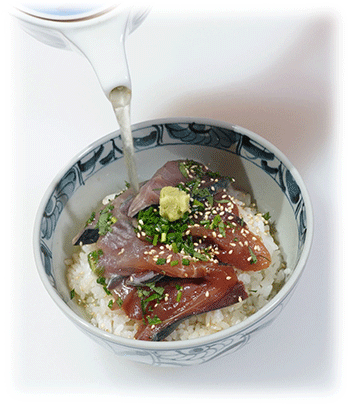
Sprinkle dark and hot green tea on it to make sesame mackerel chazuke.
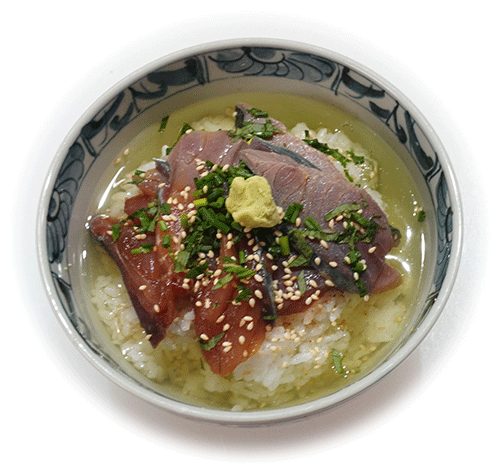
If you like, you can add some sauce or simply add a little soy sauce to finish it to your taste, but the so-called "finishing" is simple but quite good.
Furthermore, if you can't eat all the sesame mackerel in ochazuke, you can store it in the refrigerator overnight in the state of zuke, and it doesn't matter whether it's the next morning or noon. I would like to recommend using sesame mackerel bowl.
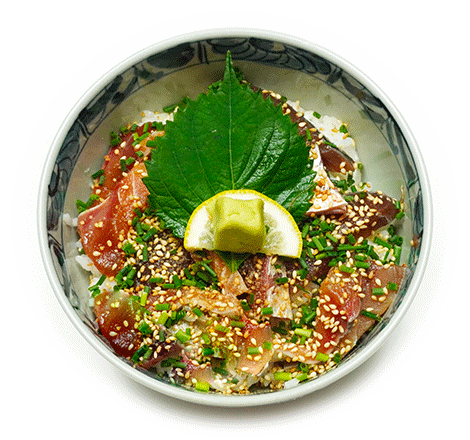
The sesame mackerel bowl that I eat the next day has enough sauce soaked in the sesame mackerel, so I don't add any more sauce. However, in order to add flavor, not only is white sesame sprinkled like snow, but also sesame seeds are added, and chopped green onions and perilla leaves are added to prevent the fishy smell of mackerel.
Let's revive blue-backed fish sashimi by utilizing Seirogan
By the way, in this month's issue, to put it in an extreme way, I have written articles so far with the feeling that an over-the-counter drug called Seirogan can be a savior in the fisheries sector. Readers may think that this feeling of writer is an overreaction. However, the fact that not only mackerel but also blue-backed fish sashimi such as saury, horse mackerel, and sardines are not sold for fear of Anisakis is a big problem for fish retailers.
From another point of view, it may be thrown away as "If you sell farmed mackerel, you don't have to worry about anything." However, such expensive farmed mackerel is unlikely to be a source of profit for the fisheries section. In addition, farmed horse mackerel, which has existed for a long time, has not been able to surpass natural horse mackerel in terms of mass even after decades. This is because they are too greasy and too soft, and they are completely different from natural horse mackerel. Cultured mackerel should also be considered different from natural mackerel.
This big news, which has a huge impact on marine products retailers, will make a difference in the keenness and insensitivity of the business sense, as to who can grasp how and how to utilize it in business. From the author's point of view, it seems that fish-related people who cannot make full use of this big news can be said to be "disqualified as a business person due to insensitivity to business opportunities." I want you to put an end to the weak posture that gives priority to personal protection when crossing a dangerous river and does not take risks and do not cross the river just by hitting the stone bridge.
For example, in the POP of the fish section, write the phrase "Resurrection of mackerel sashimi! Carefully selected with professional eyes. In case of emergency, Seirogan will protect you." And I want you to add the Anisakis killing effect of Seirogan to POP with slightly smaller letters and photos.
Although the number of saury is slightly higher than last year, the number of saury continues to be poor this year. The market price of saury is much higher than in the past, and it is not possible to sell it cheaply, but even so, if you commercialize saury as sashimi or sushi, you can somehow realize the volume and selling price that can be used as a product. With the development of cold chain freshness management, raw saury caught in northern Hokkaido can be sold as sashimi or sushi even in southern Okinawa. Because it is this time of year, it can be sold as a seasonal fish.
If you have the motivation, you can sell saury sashimi just by replacing the POP mackerel proposed above with saury. I want you to sell not only mackerel but also saury sashimi in October!
Opportunity has arrived! Wise to find business opportunities. That is a merchant.
| Please access the following URL if you want to secure using SSL. All pages in the site will be secure pages. |
https://secure02.blue.shared-server.net/www.fish-food.co.jp/message english 10.2021.html |
An opinion and the communication are to iinfo@fish food times
Date of updating 1 Oct. 2021
